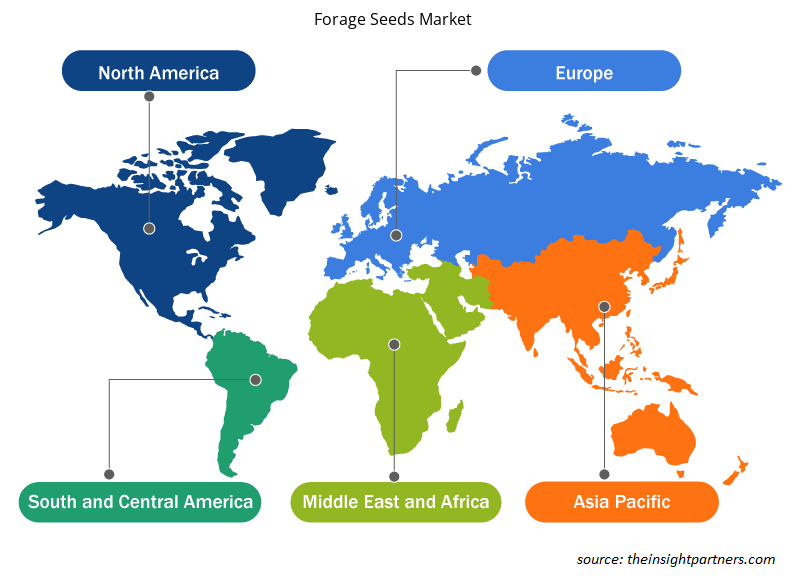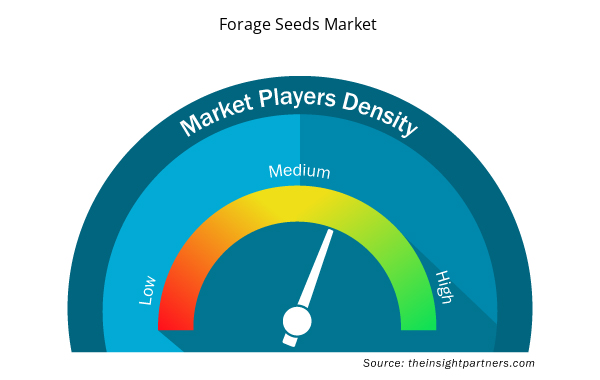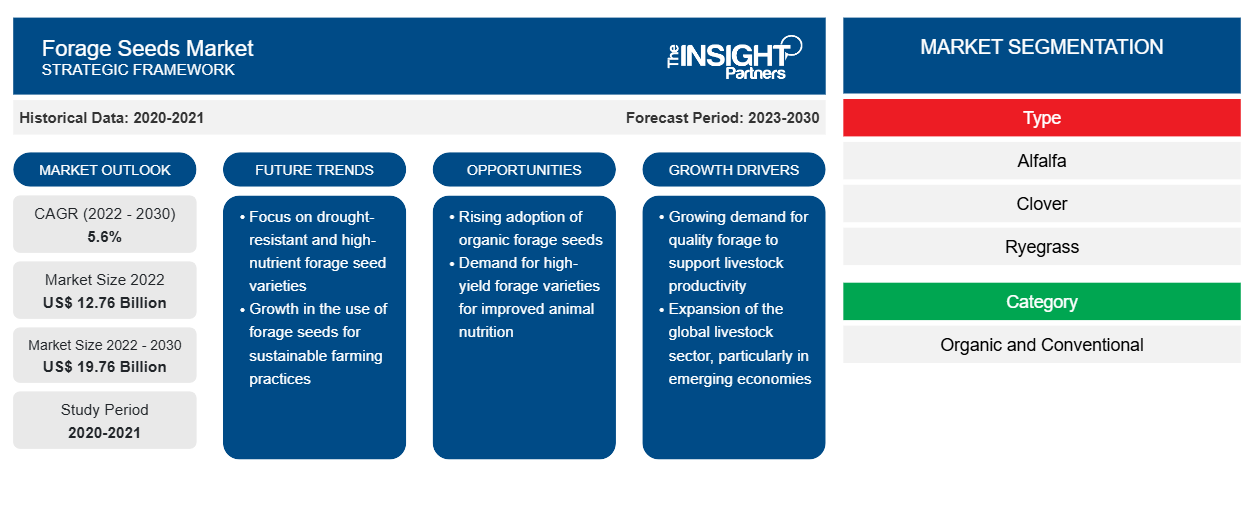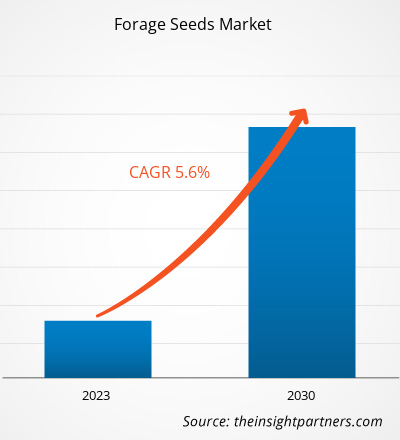[研究报告] 预计市场规模将从 2022 年的 127.57 亿美元增长到 2030 年的 197.5546 亿美元;预计 2022 年至 2030 年的复合年增长率为 5.6%。
市场洞察和分析师观点:
传统饲料通常含有大量化学物质,动物食用后会影响肉质。从长远来看,食用这种肉类会导致各种健康问题。为了解决这个问题,制造商正在开发不含化学添加剂的有机饲料。以这种饲料为食的动物提供的肉具有很高的营养价值。因此,消费者经常发现有机和天然产品是传统产品的更健康替代品。消费者主要倾向于有机产品,这鼓励制造商大量投资于用有机成分生产的产品。此外,借助互联网,消费者可以更方便地获取无限信息,这使得消费者越来越意识到自己的健康需求,从而导致对有机饲料的需求不断增加。因此,在预测期内,对有机饲料的偏好增加预计将成为牧草种子市场的一个重要趋势。
增长动力和挑战:
种子遗传学技术的进步为全球牧草种子市场的增长提供了机会。随着技术的发展,种子制造商开发了不同品种或特性的种子,例如杂交、转基因、非转基因和有机种子。农民对这些转基因品种的偏好在各个牧草种植区逐渐上升,以尽量减少杂草和疾病造成的作物损失并提高种子的质量。杂交种子是通过对同一物种的两个不同亲本植物进行特殊的、精心控制的异花授粉而开发的,以产生无法通过两种相同植物的近亲繁殖产生的新特性。通常,杂交种子是手工异花授粉的。
转基因种子是通过基因工程改变生物体的遗传物质而产生的。转基因种子是在实验室中使用现代生物技术培育的。另一方面,非转基因种子是通过授粉培育的。有机种子被视为非转基因种子。有机种子是自然产生的,无需使用杀虫剂、肥料或任何其他化学物质。这些种子具有抗病能力,并且具有在恶劣条件下茁壮成长的增强能力。
这些育种技术通过修改种子和植物细胞的 DNA 来开发具有所需特性的新种子品种。这些技术改进有助于解决农民在种植牧草种子过程中面临的挑战。因此,持续的技术改进有望在未来几年为牧草种子市场创造丰厚的机会。
定制此报告以满足您的需求
您可以免费定制任何报告,包括本报告的部分内容、国家级分析、Excel 数据包,以及为初创企业和大学提供优惠和折扣
- 获取此报告的关键市场趋势。这个免费样品将包括数据分析,从市场趋势到估计和预测。
报告细分和范围:
“全球牧草种子市场”根据类型、类别、牲畜和地理区域进行细分。根据类型,牧草种子市场细分为 [苜蓿、三叶草(白色、红色、杂交等)、黑麦草(一年生黑麦草、多年生黑麦草、意大利黑麦草和杂交黑麦草)、猫尾草、高粱、雀麦、百脉根、豇豆、草地羊茅等]。根据类别,市场细分为有机和传统。根据牲畜,牧草种子市场细分为反刍动物、家禽、猪和其他。根据地理位置,牧草种子市场分为北美洲(美国、加拿大和墨西哥)、欧洲(德国、法国、意大利、英国、俄罗斯和欧洲其他地区)、亚太地区(澳大利亚、中国、日本、印度、韩国和亚太其他地区)、中东和非洲(南非、沙特阿拉伯、阿联酋和中东和非洲其他地区)以及南美洲和中美洲(巴西、智利和南美洲和中美洲其他地区)。
节段分析:
根据牲畜,牧草种子市场细分为反刍动物、家禽、猪和其他。反刍动物部分在 2022 年占据了牧草种子市场的最大份额,预计在预测期内将实现显着增长率。反刍动物包括牛、羊、山羊和水牛。牧草是反刍动物蛋白质、纤维和能量的主要来源。豆科牧草如苜蓿和三叶草为反刍动物提供 75% 的粗蛋白。牧草为反刍动物提供大量纤维。牧草还降低了瘤胃饲料的总成本。因此,牲畜饲养者通常将牧草与动物饲料一起使用。人们对反刍动物(尤其是奶牛、山羊和绵羊以及肉牛)特定营养的认识不断提高,推动了对牧草的需求,从而推动了牧草种子市场的增长。
区域分析:
根据地理位置,牧草种子市场分为五个主要区域——北美、欧洲、亚太地区、南美和中美以及中东和非洲。全球牧草种子市场以北美为主,预计 2022 年市场规模约为 50 亿美元。北美是牧草种子的重要市场之一,因为对饲料牧草的需求增加、肉类消费和天气条件,以及尽管价格上涨、动物饲料和农业产业成熟但畜牧产品消费量增加。越来越多的人选择富含蛋白质和更健康的产品,可支配收入增加、生活方式改变和饮食模式导致美国、加拿大和墨西哥对富含蛋白质的肉类的需求激增。因此,随着肉类产品消费量的增加,对动物饲料的需求增加,并进一步推动牧草种子市场的发展。该地区是该地区最大的动物饲料生产国之一。根据 Alltech Global 的报告,2020 年,该地区生产了超过 2.54 亿公吨的动物饲料产品。北美动物饲料的大规模生产以及日益增长的食品安全问题(尤其是对肉类和奶制品的食品安全问题),导致该地区对饲料等营养动物饲料的消费量增加。
预测期内,北美养牛业的大幅增长也有望推动对草料等动物饲料的需求。例如,根据 Foothills Forage & Grazing Association 的数据,2021 年 7 月 1 日,加拿大牛存栏量为 1229 万头,比 2020 年 7 月 1 日高出 0.2%。这一增长归因于对新鲜肉类产品的需求不断增长,导致牛存栏量激增。此外,根据美国农业部 (UDSA) 的报告,2021 年,北美地区的牛存栏量超过 1.14 亿头,生猪存栏量超过 1.09 亿头。因此,牛存栏量的增加和对健康动物饲料需求的增加推动了整个地区对草料种子的需求。
行业发展和未来机遇:
以下列出了牧草种子市场主要参与者采取的各种举措:
- 2022 年 11 月,全球可持续农业解决方案提供商 UPL Ltd. 宣布,其旗下公司 Advanta Seeds UK 和 Bunge 已签署协议,分别收购 SEEDCORP|HO 20% 的股份。这项意向投资是 UPL 集团 OpenAg 目标的一部分,旨在推动合作,为农民提供一整套解决方案。
- 2022年10月,全球投资公司KKR与全球农业解决方案提供商UPL Limited宣布签署最终协议,KKR将投资3亿美元收购Ltd.子公司Advanta Enterprises Limited 13.33%的股份。
COVID-19 影响:
COVID-19 疫情影响了各国的经济和行业。北美、欧洲、亚太地区 (APAC)、南美和中美 (SAM) 以及中东和非洲 (MEA) 主要国家的旅行禁令、封锁和企业关闭对包括农业和动物饲料行业在内的各个行业的增长产生了负面影响。制造部门的关闭扰乱了全球供应链、交付计划、制造活动以及各种必需品和非必需品的销售。多家公司宣布,2020 年产品交付可能会延迟,未来产品销售可能会下滑。此外,欧洲、亚洲和北美各国政府对国际旅行实施的禁令迫使这些公司暂时搁置合作和伙伴关系计划。所有这些因素都阻碍了 2020 年和 2021 年初的动物饲料行业,从而抑制了牧草种子市场的增长。
牧草种子市场区域洞察
Insight Partners 的分析师已详细解释了预测期内影响牧草种子市场的区域趋势和因素。本节还讨论了北美、欧洲、亚太地区、中东和非洲以及南美和中美洲的牧草种子市场细分和地理位置。

- 获取牧草种子市场的区域特定数据
牧草种子市场报告范围
| 报告属性 | 细节 |
|---|---|
| 2022 年市场规模 | 127.6亿美元 |
| 2030 年的市场规模 | 197.6亿美元 |
| 全球复合年增长率(2022 - 2030 年) | 5.6% |
| 史料 | 2020-2021 |
| 预测期 | 2023-2030 |
| 涵盖的领域 | 按类型
|
| 覆盖地区和国家 | 北美
|
| 市场领导者和主要公司简介 |
|
市场参与者密度:了解其对商业动态的影响
牧草种子市场正在快速增长,这得益于终端用户需求的不断增长,而这些需求又源于消费者偏好的不断变化、技术进步以及对产品优势的认识不断提高等因素。随着需求的增加,企业正在扩大其产品范围,进行创新以满足消费者的需求,并利用新兴趋势,从而进一步推动市场增长。
市场参与者密度是指在特定市场或行业内运营的企业或公司的分布情况。它表明相对于给定市场空间的规模或总市场价值,有多少竞争对手(市场参与者)存在于该市场空间中。
在牧草种子市场运营的主要公司有:
- 联合磷化有限公司
- DLF 种子公司
- 科迪华公司
- 利马格兰英国有限公司
- S&W 种子公司
免责声明:上面列出的公司没有按照任何特定顺序排列。

- 获取牧草种子市场顶级关键参与者概述
竞争格局和重点公司:
UPL Ltd、DLF Seeds AS、Corteva Inc、Limagrain UK Ltd、S&W Seed Co、Deutsche Saatveredelung AG、Cerience、Allied Seed LLC、MAS Seeds SA 和 Syngenta AG 是全球牧草种子市场的知名企业。这些牧草种子制造商提供具有创新功能的尖端种子解决方案,为农民及其牲畜提供卓越的体验。
- 历史分析(2 年)、基准年、预测(7 年)及复合年增长率
- PEST 和 SWOT 分析
- 市场规模价值/数量 - 全球、区域、国家
- 行业和竞争格局
- Excel 数据集


- Helicopters Market
- Nitrogenous Fertilizer Market
- Smart Mining Market
- Unit Heater Market
- Quantitative Structure-Activity Relationship (QSAR) Market
- Foot Orthotic Insoles Market
- Clinical Trial Supplies Market
- Ceramic Injection Molding Market
- Machine Condition Monitoring Market
- Electronic Signature Software Market

Report Coverage
Revenue forecast, Company Analysis, Industry landscape, Growth factors, and Trends

Segment Covered
This text is related
to segments covered.

Regional Scope
North America, Europe, Asia Pacific, Middle East & Africa, South & Central America

Country Scope
This text is related
to country scope.
常见问题
The forage seeds manufacturers across the globe are investing significantly in strategic development initiatives such as product innovation, mergers and acquisitions, and expansion of their businesses to attract many consumers and enhance their market position. To maintain their strategic position in the market, key players are investing significantly in quality enhancement of forage seeds. For instance, DLF Seeds, the world's leading grass seed breeder, invested US$ 4.6 million in new state-of-the-art mixing and distribution facilities in 2021. The company has invested in transforming its current production facilities of Offshore Patrol Vessels (OPVs) and the hybrid seed of forage and bringing much-needed additional capacity and efficiency to cope with the increasing market demands by consumers and environmental stewardship in the forage seed market. Such strategic development initiatives by key players help to create a strong foothold in the market.
Based on the livestock, ruminants segment is projected to grow at the fastest CAGR over the forecast period. Ruminants include cattle, sheep, goats, and buffalo. Forage is the primary source of protein, fiber, and energy for ruminants. Leguminous forages such as alfalfa and clover provide 75% of the crude protein to ruminants. Forage grasses provide high amounts of fiber to the ruminants.
North America accounted for the largest share of the global forage seeds market. The growth in region is attributed to the increased demand for forage as feed, meat consumption, and weather conditions, as well as rising consumption of livestock products despite the rising prices, well-established animal feed, and agriculture industry. An increasing number of individuals opting for protein-rich and healthier products, growing disposable income, lifestyle changes, and eating patterns contribute to a surge in demand for protein-rich meat in the US, Canada, and Mexico. Thus, with the rising consumption of meat products, the demand for animal feed increases and further drives the market for forage seeds. The region accounts for one of the largest animal feed producers across the region. As per the report of Alltech Global, in 2020, the region produced more than 254 million metric tons of animal feed products. The mass production of animal feed in North America and the rising food safety concerns, especially about meat and dairy products, have led to the increased consumption of nutritional animal feed such as forages in the region.
Based on category, conventional segment mainly has the largest revenue share. Conventional forage seeds are grown using chemical fertilizers, genetically modified organisms (GMOs), and chemical pesticides. Conventional forage seeds provide higher yields than organic ones due to the use of GMOs and chemical fertilizers. Moreover, conventional forage seeds are highly affordable and readily available.
The major players operating in the global forage seeds market are UPL Ltd, DLF Seeds AS, Corteva Inc, Limagrain UK Ltd, S&W Seed Co, Deutsche Saatveredelung AG, Cerience, Allied Seed LLC, MAS Seeds SA, and Syngenta AG.
The seed manufacturers have developed different varieties or traits of seeds, such as hybrid, GMO, non-GMO, and organic seeds, with technological developments. The farmer's preference for these transgenic varieties is slowly rising in various forage-growing regions to minimize crop losses by weeds and diseases and enhance the quality of seeds. The hybrid seeds are developed by the special, carefully controlled cross-pollination of two different parent plants of the same species to produce new traits that cannot be created by the inbreeding of two of the same plants. Usually, the hybrid seeds are cross-pollinated by hand.
Trends and growth analysis reports related to Food and Beverages : READ MORE..
The List of Companies - Forage Seeds Market
- UPL Ltd
- DLF Seeds AS
- Corteva Inc
- Limagrain UK Ltd
- S&W Seed Co
- Deutsche Saatveredelung AG
- Cerience
- Allied Seed LLC
- MAS Seeds SA
- Syngenta AG
The Insight Partners performs research in 4 major stages: Data Collection & Secondary Research, Primary Research, Data Analysis and Data Triangulation & Final Review.
- Data Collection and Secondary Research:
As a market research and consulting firm operating from a decade, we have published and advised several client across the globe. First step for any study will start with an assessment of currently available data and insights from existing reports. Further, historical and current market information is collected from Investor Presentations, Annual Reports, SEC Filings, etc., and other information related to company’s performance and market positioning are gathered from Paid Databases (Factiva, Hoovers, and Reuters) and various other publications available in public domain.
Several associations trade associates, technical forums, institutes, societies and organization are accessed to gain technical as well as market related insights through their publications such as research papers, blogs and press releases related to the studies are referred to get cues about the market. Further, white papers, journals, magazines, and other news articles published in last 3 years are scrutinized and analyzed to understand the current market trends.
- Primary Research:
The primarily interview analysis comprise of data obtained from industry participants interview and answers to survey questions gathered by in-house primary team.
For primary research, interviews are conducted with industry experts/CEOs/Marketing Managers/VPs/Subject Matter Experts from both demand and supply side to get a 360-degree view of the market. The primary team conducts several interviews based on the complexity of the markets to understand the various market trends and dynamics which makes research more credible and precise.
A typical research interview fulfils the following functions:
- Provides first-hand information on the market size, market trends, growth trends, competitive landscape, and outlook
- Validates and strengthens in-house secondary research findings
- Develops the analysis team’s expertise and market understanding
Primary research involves email interactions and telephone interviews for each market, category, segment, and sub-segment across geographies. The participants who typically take part in such a process include, but are not limited to:
- Industry participants: VPs, business development managers, market intelligence managers and national sales managers
- Outside experts: Valuation experts, research analysts and key opinion leaders specializing in the electronics and semiconductor industry.
Below is the breakup of our primary respondents by company, designation, and region:

Once we receive the confirmation from primary research sources or primary respondents, we finalize the base year market estimation and forecast the data as per the macroeconomic and microeconomic factors assessed during data collection.
- Data Analysis:
Once data is validated through both secondary as well as primary respondents, we finalize the market estimations by hypothesis formulation and factor analysis at regional and country level.
- Macro-Economic Factor Analysis:
We analyse macroeconomic indicators such the gross domestic product (GDP), increase in the demand for goods and services across industries, technological advancement, regional economic growth, governmental policies, the influence of COVID-19, PEST analysis, and other aspects. This analysis aids in setting benchmarks for various nations/regions and approximating market splits. Additionally, the general trend of the aforementioned components aid in determining the market's development possibilities.
- Country Level Data:
Various factors that are especially aligned to the country are taken into account to determine the market size for a certain area and country, including the presence of vendors, such as headquarters and offices, the country's GDP, demand patterns, and industry growth. To comprehend the market dynamics for the nation, a number of growth variables, inhibitors, application areas, and current market trends are researched. The aforementioned elements aid in determining the country's overall market's growth potential.
- Company Profile:
The “Table of Contents” is formulated by listing and analyzing more than 25 - 30 companies operating in the market ecosystem across geographies. However, we profile only 10 companies as a standard practice in our syndicate reports. These 10 companies comprise leading, emerging, and regional players. Nonetheless, our analysis is not restricted to the 10 listed companies, we also analyze other companies present in the market to develop a holistic view and understand the prevailing trends. The “Company Profiles” section in the report covers key facts, business description, products & services, financial information, SWOT analysis, and key developments. The financial information presented is extracted from the annual reports and official documents of the publicly listed companies. Upon collecting the information for the sections of respective companies, we verify them via various primary sources and then compile the data in respective company profiles. The company level information helps us in deriving the base number as well as in forecasting the market size.
- Developing Base Number:
Aggregation of sales statistics (2020-2022) and macro-economic factor, and other secondary and primary research insights are utilized to arrive at base number and related market shares for 2022. The data gaps are identified in this step and relevant market data is analyzed, collected from paid primary interviews or databases. On finalizing the base year market size, forecasts are developed on the basis of macro-economic, industry and market growth factors and company level analysis.
- Data Triangulation and Final Review:
The market findings and base year market size calculations are validated from supply as well as demand side. Demand side validations are based on macro-economic factor analysis and benchmarks for respective regions and countries. In case of supply side validations, revenues of major companies are estimated (in case not available) based on industry benchmark, approximate number of employees, product portfolio, and primary interviews revenues are gathered. Further revenue from target product/service segment is assessed to avoid overshooting of market statistics. In case of heavy deviations between supply and demand side values, all thes steps are repeated to achieve synchronization.
We follow an iterative model, wherein we share our research findings with Subject Matter Experts (SME’s) and Key Opinion Leaders (KOLs) until consensus view of the market is not formulated – this model negates any drastic deviation in the opinions of experts. Only validated and universally acceptable research findings are quoted in our reports.
We have important check points that we use to validate our research findings – which we call – data triangulation, where we validate the information, we generate from secondary sources with primary interviews and then we re-validate with our internal data bases and Subject matter experts. This comprehensive model enables us to deliver high quality, reliable data in shortest possible time.


 获取此报告的免费样本
获取此报告的免费样本